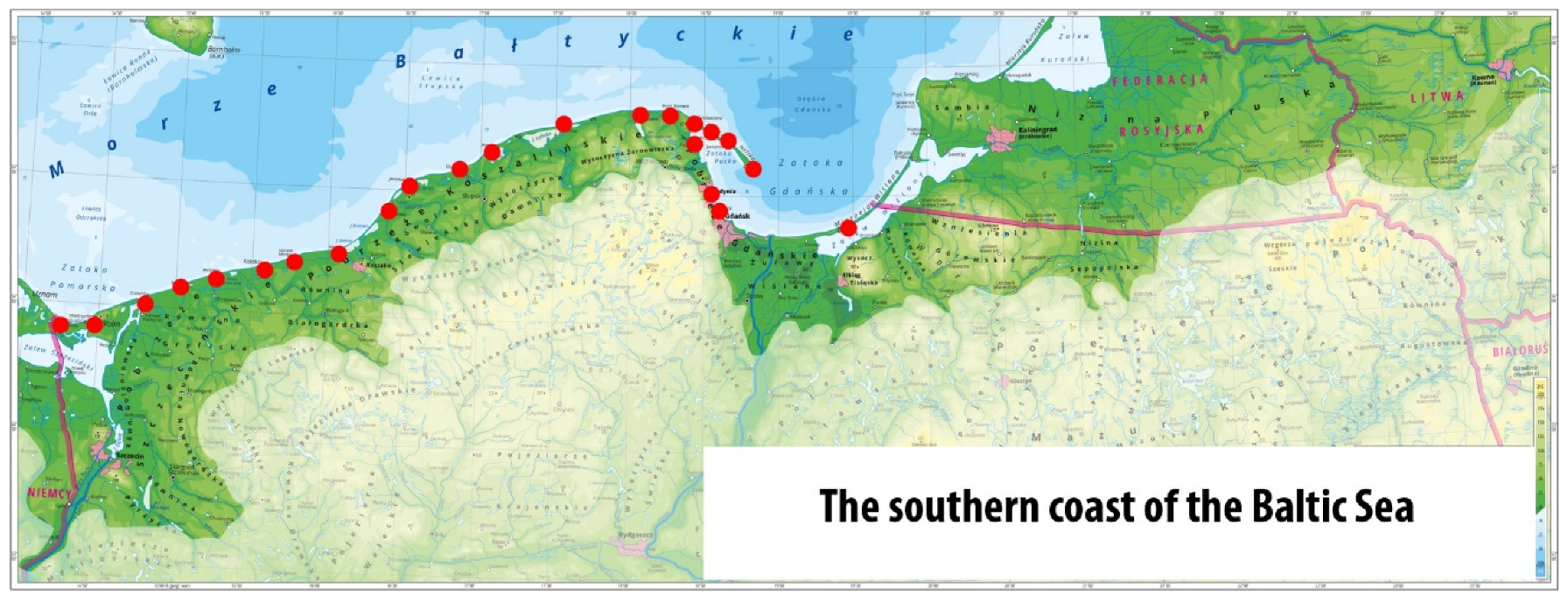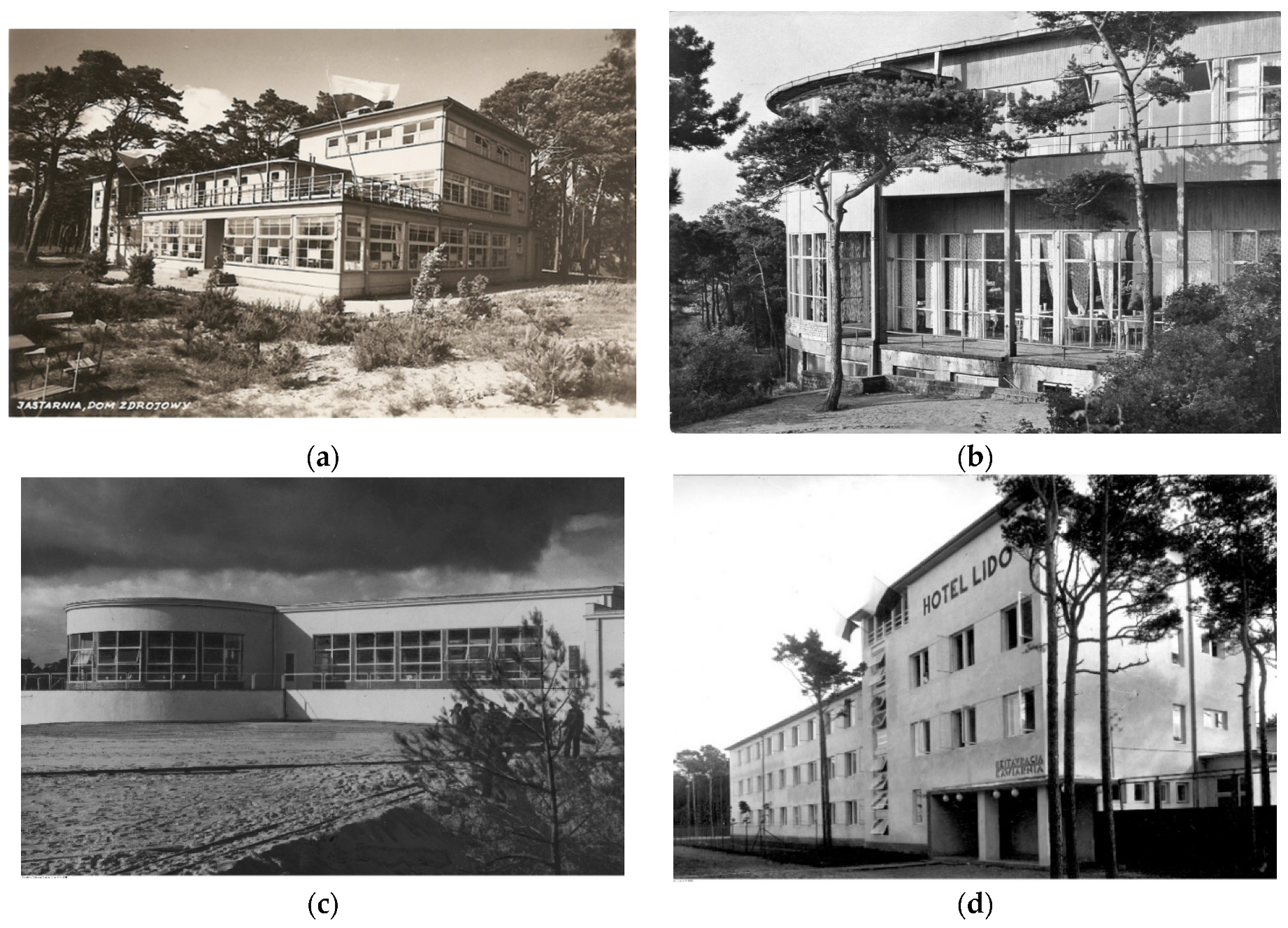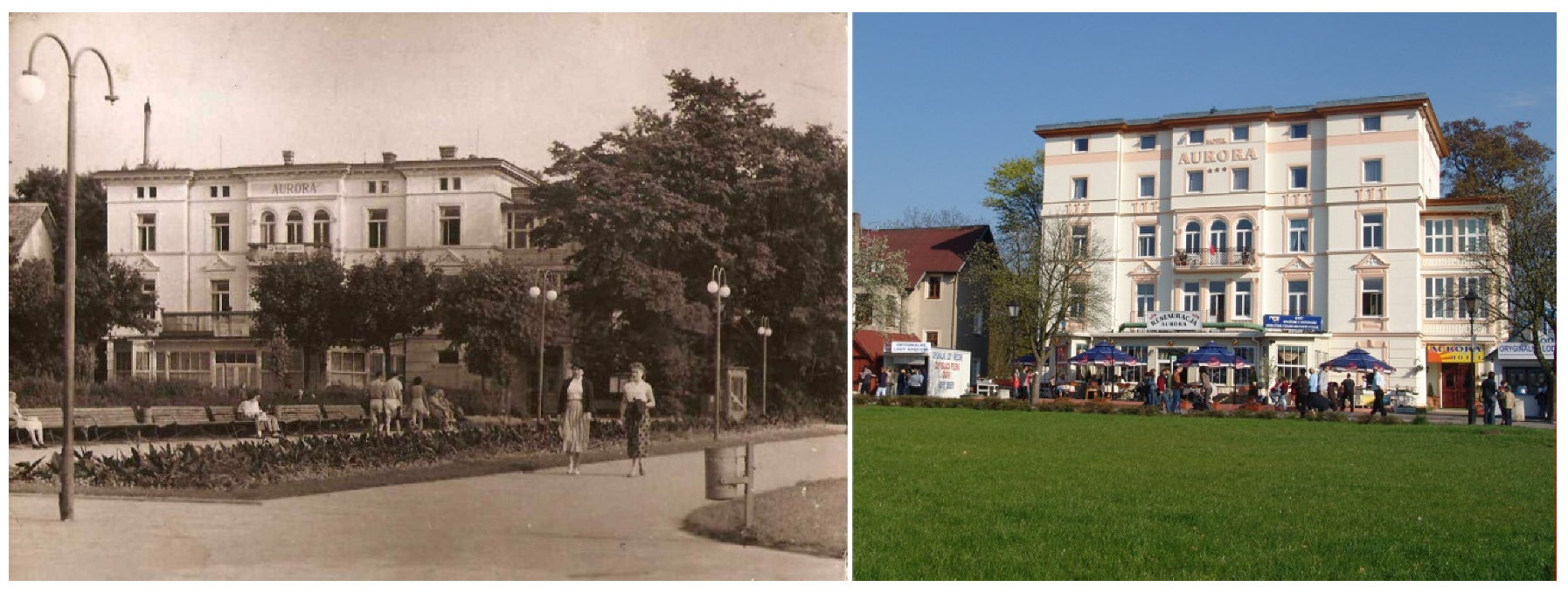The Stages of the Cultural Landscape Transformation of Seaside Resorts in Poland against the Background of the Evolving Nature of Tourism
Abstract
:1. Introduction and Past Studies on Tourism Development
1.1. Introduction
1.2. Past Studies
1.3. Research Goals
- To analyze tourism development for its impact on the cultural landscape of seaside resorts on the Baltic coastline of Poland;
- To identify, on the basis of transformations of the nature and forms of recreation, the particular stages of the shaping of spatial elements in seaside resorts and recreational architecture and to indicate characteristic features of architecture and landscape.
2. Materials and Methods
- Iconology and iconography—interpretation of graphic representations (e.g., historic postcards),
- Historiography—archival research (e.g., archived documents),
- Secondary description (aerial photographs),
- Observation—site studies and photography analysis,
- Query project documentations.
3. Results: Development of Tourism in the Context of Its Impact on the Architecture and Cultural Landscape of Seaside Resorts in Poland
3.1. From 19th Century to 1918
3.2. The Interwar Period (1918–1939)
3.3. The Post-War Period (1945–1989)
3.4. The Period after 1989
4. Discussion—Stages of Transformation of the Cultural Landscape of Coastal Towns in Poland
- Stage I: Formation—Elite resort (main features: elite tourism, the first buildings associated with the recreation and therapeutic function, public space as an important compositional element, architecture adapted to the expectations of the elite) (Supplementary Materials available online: Supplementary Materials S1—Stage I: Elite resort—architecture and landscape);
- Stage II: Regionalism—National resort (main features: tourism becoming common, intensive development of the curative idea, a mature form of a seaside resort, search for a national style) (Supplementary Materials available online: Supplementary Materials S2—Stage II: National resort—architecture and landscape);
- Stage III: Socialization—A resort for working masses (main features: model of the state organization of recreation, loss of cultural continuity of the landscape, devaluation of public space, the establishment of holiday centers) (Supplementary Materials available online: Supplementary Materials S3—Stage III: A resort for working masses—architecture and landscape);
- Stage IV: Pluralism—Egalitarian resort (main features: mass tourism, numerous investments strongly interfering with the landscape, architectural eclecticism, regional features reduced to a minimum, unification) (Supplementary Materials available online: Supplementary Materials S4—Stage IV: Egalitarian resort—architecture and landscape).
5. Conclusions
Supplementary Materials
Author Contributions
Funding
Conflicts of Interest
References
- GUS-Statistical Office. Tourism in 2018, Statistical Analyses; Zakład Wyd. Statystycznych: Warszawa, Poland, 2018. Available online: https://stat.gov.pl/obszary-tematyczne/kultura-turystyka-sport/turystyka/turystyka (accessed on 10 September 2019).
- Hall, C. Trends in ocean and coastal tourism: The end of the last frontier? Ocean Coast. Manag. 2001, 44, 601–618. [Google Scholar] [CrossRef]
- Hughes, H. Arts, Entertainment and Tourism; Butterworth-Heinemann: Burlington, UK, 2003. [Google Scholar]
- World Tourism Organization. Compendium of Tourism Statistics, Data 2013–2017; UNWTO: Madrid, Spain, 2019; Available online: https://www.e-unwto.org/doi/book/10.18111/9789284420421 (accessed on 10 September 2019).
- World Travel & Tourism Council. City Travel & Tourism Economic Impact Report; WT&TC: London, UK, 2019; Available online: https://www.wttc.org/economic-impact/city-analysis#undefined (accessed on 10 September 2019).
- Ritzer, G. The McDonaldization of Society: An Investigation into the Changing Character of Contemporary Social Life; Pine Forge Press: Thousand Oaks, CA, USA, 1993. [Google Scholar]
- Henderson, J.C. Planning, Changing Landscapes and Tourism in Singapore. J. Sustain. Tour. 2005, 13, 123–135. [Google Scholar] [CrossRef]
- Relph, E. Place and Placelessness; Pion: London, UK, 1976. [Google Scholar]
- Goonatilake, S. Tourism in Sri Lanka. The Mapping of Intrantional Inequalities and Their Internal Structural Effects; Centre for Developing Area, McGill University: Montreal, QC, Canada, 1978. [Google Scholar]
- Boorstin, D. The Image: A Guide to Pseudo-Events in America; Harper: New York, NY, USA, 1964. [Google Scholar]
- Saarinen, J. Enclavic tourism spaces: Territorialization and bordering in tourism destination development and planning. Tour. Geogr. 2017, 19, 425–437. [Google Scholar] [CrossRef] [Green Version]
- Chang, Y.; Chu, K.; La Chuang, L.Z. Sustainable coastal zone planning based on historical coastline changes: A model from case study in Tainan, Taiwan. Landsc. Urban Plan. 2018, 174, 24–32. [Google Scholar] [CrossRef]
- Getz, D. Tourism Planning and Destination Life Cycle. Ann. Tour. Res. 1992, 19, 752–770. [Google Scholar] [CrossRef]
- Gilbert, E.W. The growth of inland and seaside health resorts in England. Scott. Geogr. Mag. 1939, 55, 16–35. [Google Scholar]
- Christaller, W. Some considerations of tourism location in Europe. Pap. Reg. Sci. Assoc. 1963, 12, 95–105. [Google Scholar]
- Lundgren, J.O.J. The Tourist Frontier of Nouveau Quebec: Functions and regional linkages. Tour. Rev. 1982, 37, 10–16. [Google Scholar] [CrossRef]
- Miossec, J.M. Elèments Pour une Thèorie de l’Espace Touristique, Les Cahiers du Tourisme; CHET: Aix-en-Provence, France, 1976. [Google Scholar]
- Butler, R.W. The concept of the tourist area life-cycle of evolution: Implications for management of resources. Can. Geogr. 1980, 24, 5–12. [Google Scholar] [CrossRef]
- Keller, C.P. Stages of Peripheral Tourism Development—Canada’s Northwest Territories. Tour. Manag. 1987, 8, 20–32. [Google Scholar] [CrossRef]
- Zhang, C.H.; Xiao, H. Destination development in China: Towards an effective model of explanation. J. Sustain. Tour. 2014, 22, 214–233. [Google Scholar] [CrossRef] [Green Version]
- Lewis, J.B. A Rural Tourism Development Model. Tour. Anal. 1998, 2, 91–105. [Google Scholar]
- Ritchie, J.R.B.; Crouch, G.I. The Competitive Destination, A Sustainable Tourism Perspective; CABI Publishing: Wallingford Oxon, UK, 2003. [Google Scholar]
- Bianchi, R. Tourism Development and Resort Dynamics: An Alternative Approach. In Progress in Tourism, Recreation and Hospitality Management; Cooper, C.P., Lockwood, A., Eds.; Belhaven: London, UK, 1994; Volume 5, pp. 181–193. [Google Scholar]
- Liu, W.; Vogt, C.A.; Lupi, F.; He, G.; Ouyang, Z.; Liu, J. Evolution of tourism in a flagship protected area of China. J. Sustain. Tour. 2016, 24, 203–226. [Google Scholar] [CrossRef]
- Nelson, R.; Wall, G. Transportation and accommodation: Changing interrelationships on Vancouver Island. Ann. Tour. Res. 1986, 13, 239–260. [Google Scholar] [CrossRef]
- Petrevska, B.; Collins-Kreiner, N. A double life cycle: Determining tourism development in Macedonia. J. Tour. Cult. Chang. 2017, 15, 319–338. [Google Scholar] [CrossRef]
- Williams, S. Tourism. Critical Concepts in the Social Sciences; Routledge: London, UK, 2004. [Google Scholar]
- Choy, D.J.L. Life Cycle Models for Pacific Island Destinations. J. Travel Res. 1992, 30, 26–31. [Google Scholar] [CrossRef]
- Liszewski, S. Przestrzeń turystyczna. Turyzm 1995, 5, 87–103. [Google Scholar]
- Butowski, L. Maritime Tourism Space. Turyzm 2014, 24, 57–64. [Google Scholar] [CrossRef]
- Butowski, L. Model of sustainable tourism. Teoretical and empirical approach. Folia Tur. 2014, 33, 9–33. [Google Scholar]
- Gormsen, E. The spatio-temporal development of international tourism: Attempt at a centre-periphery model. In La Consommation d’Espace par le Tourisme et sa Preservation; Intenational Geographical Union, Ed.; CHET: Aix-en-Provence, France, 1981; pp. 150–170. [Google Scholar]
- Smith, R.A. Beach resorts: A model of development evolution. Landsc. Urban Plan. 1991, 21, 189–210. [Google Scholar] [CrossRef]
- Barrett, J.A. The Seaside Resort Towns of England and Wales. Ph.D. Thesis, University of London, London, UK, 1958. [Google Scholar]
- Liszewski, S. Przestrzeń turystyczna i osadnictwo turystyczne. In Kompendium wiedzy o turystyce; Gołembski, G., Ed.; Wyd. Naukowe PWN: Warszawa, Poland, 2002; pp. 77–109. [Google Scholar]
- Hollowey, J.C.; Taylor, N. The Business of Tourism; Pearson Education: London, UK, 2006. [Google Scholar]
- Bal, W. Specyfika krajobrazu kulturowego kurortów nadmorskich. Próba określenia tożsamości kulturowej regionu nadmorskiego w kontekście postępującej degradacji krajobrazu kulturowego kurortów nadmorskich na Pomorzu Zachodnim [Specificity of the Cultural Landscape of seaside resorts. An attempt to determine the cultural identity of a coastal region in the context of the progressive degradation of the cultural landscape of seaside resorts in Western Pomerania]; Wyd HOGBEN: Szczecin, Poland, 2009. [Google Scholar]
- Gawkowski, R. Wypoczynek w II Rzeczpospolitej: Kururty, rekreacja, zabawa [Recreation in the Second Polish Republic: Resorts, Recreation, Fun]; Dragon: Bielsko Biała, Poland, 2011. [Google Scholar]
- Grey, F. Designing the Seaside; Reaction Books: London, UK, 2006. [Google Scholar]
- Collection of Documents Maps and Photographs on the History of the City Świnoujście and West Pomeranian Coast; Museum of Sea Fisheries in Świnoujście: Świnoujście, Poland, 1890–1945.
- Gazeta Morze [Sea Newspaper]; Organ Ligi Morskiej i Rzecznej: Warszawa, Poland, 1928.
- Orłowicz, M. Plan Rozwoju Polskiego Wybrzeża [Development Plan for the Polish Coast]; Ministerstwo Robót Publicznych: Warszawa, Poland, 1928. [Google Scholar]
- Polskie Uzdrowiska [Polish Spas.] (a booklet); Zakłady Graficzne im. Marcina Kasprzaka w Poznaniu: Poznań, Poland, 1950.
- Dobrowolska-Kierył, M. Przedwojenne Wybrzeże. Najpiękniejsze Fotografie [Pre-War Coast. The Most Beautiful Photographs.]; Wyd. RM: Warszawa, Poland, 2011. [Google Scholar]
- Staśko, J. Przewodnik po polskiem wybrzeżu [Polish Coast Guide]; PTKK RUCH: Kraków, Poland, 1926. [Google Scholar]
- Lachowski, J. (Ed.) Monografia wielkiego Pomorza i Gdyni [Monograph of Greater Pomerania and Gdynia]; Wyd. “Polska Niepodległa”: Toruń, Poland, 1939. [Google Scholar]
- Zimmermann, D. Każdy chce zobaczyć z bliska Gdańsk i bałtyckie kąpieliska. Als Reiseziel erwahl sich jader Danzig und seine Ostseebader [Everyone Wants to See Gdańsk and the Baltic Seaside Resorts Up Close]; Bernardinum: Pelplin, Poland, 2008. [Google Scholar]
- Archiwum Cyfrowe Gdynia w Sieci [Digital Gdynia Archive on the Web]. Available online: http://www.gdyniawsieci.pl/kolekcje-archiwum-cyfrowego/orlowo-i-kolibki-na-pocztowkach-do-1939-roku/ (accessed on 10 October 2019).
- Konstytucja Polskiej Rzeczypospolitej Ludowej [Constitution of the Polish People’s Republic]. Dz.U. 1952 no. 33 poz. 232. Available online: http://prawo.sejm.gov.pl/isap.nsf/download.xsp/WDU19520330232/O/D19520232.pdf (accessed on 15 October 2019).
- GUS-Statistical Office. Tourism in 2010, Statistical Analyses; Zakład Wyd. Statystycznych: Warszawa, Poland, 2010. Available online: https://stat.gov.pl/obszary-tematyczne/kultura-turystyka-sport/turystyka/ (accessed on 15 October 2019).
- Durydiwka, M.; Duda-Gromada, K. Influence of Tourism on the Spatial Development of Seaside Resorts: Selected Aspects. Tourism 2014, 24, 59–65. [Google Scholar] [CrossRef] [Green Version]
- Saarinen, J. Destinations in change: The transformation process of tourist destinations. Tour. Stud. 2004, 4, 161–179. [Google Scholar] [CrossRef]
- Jennings, S. Landscape Sensitivity and Tourism Development. J. Sustain. Tour. 2004, 12, 271–288. [Google Scholar] [CrossRef]
- Stoffelen, A.; Vanneste, D. An integrative geotourism approach: Bridging conflicts in tourism landscape research. Tour. Geogr. 2015, 17, 544–560. [Google Scholar] [CrossRef]
- Stumpf, T.S.; Cheshire, C.L. The land has voice: Understanding the land tenure—Sustainable tourism development nexus in Micronesia. J. Sustain. Tour. 2019, 27, 957–973. [Google Scholar] [CrossRef]
- Dziegdzieć, E. Urbanizacja turystyczna terenów wiejskich w Polsce [Tourist urbanization of rural areas in Poland]. Turyzm 1995, 5, 5–56. [Google Scholar]
- Bal, W. Pluralistic directions of development of the coastal landscape in Western Pomerania. Files Urban Plan. Archit. Comm. Branch PAS Krakow 2018, 46, 483–495. [Google Scholar]
- Williams, A.M.; Hall, C.M. Tourism and migration: New relationships between production and consumption. Tour. Geogr. 2000, 2, 5–27. [Google Scholar] [CrossRef]
- Salinas, E.; Mundet, L.; Salinas, E. Historical Evolution and Spatial Development of Tourism in Cuba, 1919–2017: What is Next? Tour. Plan. Dev. 2018, 15, 216–238. [Google Scholar] [CrossRef]
- Smith, R. Review of Integrated Beach Resort Development in Southeast Asia. Land Use Policy 1992, 9, 209–217. [Google Scholar] [CrossRef]
- Young, B. Touristization of Traditional Maltese Fishing-farming Villages. Tour. Manag. 1983, 4, 35–41. [Google Scholar] [CrossRef]
- Kraś, J. Początki turystyki w Polsce [The beginnings of tourism in Poland]. Saec. Christanum 2008, 15, 165–179. [Google Scholar]
- Lewan, M. Zarys Dziejów Turystyki w Polsce [An Outline of the History of Tourism in Poland]; Proksenia: Kraków, Poland, 2004. [Google Scholar]
- Lijewski, T.; Mikułowski, B.; Wyrzyskowski, J. Geografia Turystyki [Tourism Geography]; PWE: Warszawa, Poland, 1992. [Google Scholar]
- Pevsner, N. An Outline of European Architecture; Penguin Books: Harmondsworth, UK, 1960. [Google Scholar]
- Sharp, D. (Ed.) The Rationalists: Theory and Design in the Modern Movement; Architectural Press: London, UK, 1978. [Google Scholar]
- Kotarbiński, A. Rozwój Urbanistyki i Architektury Polskiej Wlatach 1944–1964 [Development of Urban Planning and Polish Architecture in 1944–1964]; PWN: Warszawa, Poland, 1967. [Google Scholar]
- Szafer, T. Współczesna architektura polska: Antologia czterdziestolecia. Contemporary Polish Architecture; Arkady: Warsaw, Poland, 1987. [Google Scholar]
- Czyżewski, A. Polska Architektura Nowoczesna. Modern Polish Architecture; Stowarzyszenie Architektów Polskich SARP: Warszawa, Poland, 2010. [Google Scholar]











| Locality | Establishment | Origin | Beginning of the Therapeutic Function 1 | Factors Influencing the Development | Direction of Changes |
|---|---|---|---|---|---|
| Świnoujście (Swinemünde) | 1743 | port town | 1824 | railway line to Berlin (1876) brine deposits (1890–1898) | Luxury resort, health resort |
| Międzyzdroje (Misdroy) | 12th century | fishing village | 1832 | railway line to Świnoujście (1902) | summer resort, bathing resort |
| Dziwnów (Divenov) | 12th century | fishing village | 1828 | brine deposits (late 19th century) | summer resort, bathing resort |
| Pobierowo (Poberow) | 14th century | knights’ estate | 1906 | bus link to Berlin (early 20th century) | summer resort, bathing resort |
| Rewal (Rewahl) | 2nd half of the 14th century | fishing village | 1895 | narrow-gauge railway line to Gryfice (1896) | summer resort, bathing resort |
| Niechorze (Horst) | 14th century | fishing village | 1870 | narrow-gauge railway line to Gryfice (1896) | summer resort, bathing resort |
| Ustronie Morskie (Henkenhagen) | 13th century | fishing village | 1899 | railway line from Koszalin to Kołobrzeg (1899) | bathing resort, health resort |
| Kołobrzeg (Kolberg) | 8th century | port town | 1830 | deposits of brine and therapeutic mud (early 19th century) railway connections with Szczecin and Gdańsk (1859) decommissioning of fortifications (1872) | health resort |
| Dąbki (Neuwasser) | 13th century | fishing village | 1915 | road from Koszalin to Darłowo (1927) | bathing resort, health resort |
| Ustka (Stolpmunde) | 5th–6th century | port town | 1911 | railway line (1878) | bathing resort, health resort |
| Łeba (Leba) | 13th century | fishing village | 1906 | road from Łeba to Lębork railway line to Lębork (1899) | summer resort, bathing resort |
| Sopot (Zoppot) | 13th century | fishing village | 1819 | railway line from Koszalin to Gdańsk (1870) | Luxury resort |
| Jurata | 1928 | part of the town of Jastarnia | 1931 | railway line from Gdynia to Hel (1922/1923) | Luxury resort |
| Hel (Hela) | 12th century | fishing village | 1896 | railway line from Gdynia to Hel (1922) | summer resort, health resort |
| Połąga (Palanga) | early 19th century | summer seat of the Polish aristocracy | 1840s | Investments of the Tyszkiewicz family | Gentry resort |
| Stage of Shaping Seaside Resorts | Tourism | Architectural Features | Impact on Landscape |
|---|---|---|---|
| Stage I: Formation—Elite resort (early 19th century 20th century) | Elite tourism | the first buildings associated with the recreation and therapeutic function; representative buildings inspired by Renaissance and Classicism; villas with bay windows, sophisticated towers; “Swiss style”—wooden summer architecture (late 19th century); Norwegian style architecture (until 1910) | few tourists and little impact on the landscape; areas with low forest coverage; the first parks, promenades, walking alleys and squares; public space as an important compositional element and summer drawing room for the upper classes cultural landscape formation |
| Stage II: Regionalism—National resort (1918–1939) | Popularized tourism | rejection of the Swiss style; regionalism, manor style; search for the national style—modernism inspired by ship style; new leisure facilities | intensive development of the curative idea and developing a mature form of a seaside town (national resort); new holiday resorts founded on raw root; the main arrangement element—a promenade parallel to the shoreline, a pier—a perpendicular element going out into the sea; characteristic elements of the landscape: beach pavilions and bathing areas; |
| Stage III: Socialization—Resort for working masses (1945–1989) | Package tourism (in socialism) | establishment of holiday centers (usually large buildings or complexes of cabins); introduction of facilities with non-matching appearance; standardization and repeatability of solutions; futuristic examples of modernist architecture | gradual loss of the original founding character of resorts; point devaluation of the landscape; partly appropriated beaches (gastronomic services in the dunes belt); devaluation of public space; loss of landscape cultural continuity; |
| Stage IV: Pluralism—an Egalitarian health resort (since 1989) | Mass tourism—snowballing | the development based on hotels of renown chains (“second houses”), large hotel complexes (“luxury residential buildings”); dense, “frontage buildings” the dominance of buildings of large cubic capacity, self-sufficient facilities with extensive catering, sports and recreation base; architectural eclecticism, regional features reduced to a minimum | numerous investments on the coast strongly interfering with the landscape; mass degradation of landscape localities becoming more and more similar to each other; urbanization and commercialization of space; attractions such as amusement parks; chaos and lack of spatial order; discontinuity of the public space; the phenomenon of the ‘merging’ of towns |
© 2020 by the authors. Licensee MDPI, Basel, Switzerland. This article is an open access article distributed under the terms and conditions of the Creative Commons Attribution (CC BY) license (http://creativecommons.org/licenses/by/4.0/).
Share and Cite
Bal, W.; Czalczynska-Podolska, M. The Stages of the Cultural Landscape Transformation of Seaside Resorts in Poland against the Background of the Evolving Nature of Tourism. Land 2020, 9, 55. https://doi.org/10.3390/land9020055
Bal W, Czalczynska-Podolska M. The Stages of the Cultural Landscape Transformation of Seaside Resorts in Poland against the Background of the Evolving Nature of Tourism. Land. 2020; 9(2):55. https://doi.org/10.3390/land9020055
Chicago/Turabian StyleBal, Wojciech, and Magdalena Czalczynska-Podolska. 2020. "The Stages of the Cultural Landscape Transformation of Seaside Resorts in Poland against the Background of the Evolving Nature of Tourism" Land 9, no. 2: 55. https://doi.org/10.3390/land9020055
APA StyleBal, W., & Czalczynska-Podolska, M. (2020). The Stages of the Cultural Landscape Transformation of Seaside Resorts in Poland against the Background of the Evolving Nature of Tourism. Land, 9(2), 55. https://doi.org/10.3390/land9020055





